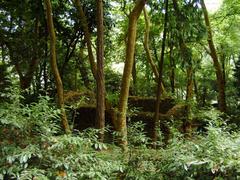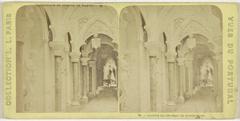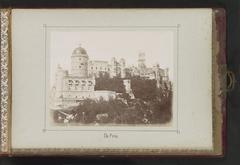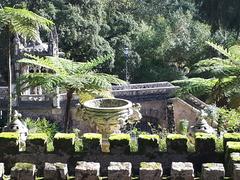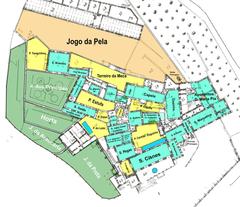Pelourinho de Sintra: Visiting Hours, Tickets, and Sintra’s Historic Sites
Date: 03/07/2025
Introduction
Located in the vibrant heart of Sintra’s UNESCO-listed historic center, the Pelourinho de Sintra is a powerful emblem of Sintra’s medieval justice system and municipal autonomy. This Manueline-style pillory—originally dating to the early 16th century—stands as a testament to Sintra’s civic pride, artistic traditions, and evolving cultural identity. Whether you’re a history enthusiast, architecture lover, or a curious traveler, this guide presents detailed insights on the pelourinho’s origins, symbolism, visiting information, and its integration with Sintra’s rich heritage (Sintra Explorers; paisagemcultural.sintra.pt; Visit Portugal).
Table of Contents
- Introduction
- Historical Overview and Significance
- Architectural Features and Symbolism
- Visiting Hours, Tickets, and Accessibility
- Getting There and Travel Tips
- Nearby Attractions
- Events and Cultural Engagement
- Frequently Asked Questions (FAQ)
- Visitor Experience and Recommendations
- References
Historical Overview and Significance
Origins and Municipal Authority
The Pelourinho de Sintra has its roots in the town’s medieval assertion of municipal self-governance. Pillories were erected across Portugal from the 12th century as physical markers of a town’s right to administer justice, following the grant of a royal charter (“foral”). In Sintra, the pelourinho’s establishment coincided with its growing importance as a royal retreat and administrative hub. The site’s prominent placement near the Sintra National Palace further underscored its role as the town’s civic and judicial nucleus (Tourist Places Guide).
Transformation Over Time
While originally constructed in the early 16th century to commemorate the “Foral de Leitura Nova” issued by King Manuel I, the original structure was dismantled during 19th-century liberal reforms. The current monument, a faithful replica created in 1940 by master sculptor José da Fonseca, upholds the town’s commitment to heritage preservation and public memory (paisagemcultural.sintra.pt).
Architectural Features and Symbolism
Design and Manueline Influence
The Pelourinho de Sintra is a striking example of Portuguese Manueline architecture—a style marked by ornate, maritime-inspired motifs from the Age of Discoveries. Its distinctive features include:
- Three Hexagonal Steps: Providing ceremonial elevation and a rare geometric foundation.
- Twisted Column (Fuste): Consists of two cylindrical drums adorned with fleurons, reflecting the Manueline era’s artistic sensibilities.
- Decorated Capital with “Ferros dos Suplícios”: Historically used to display instruments of punishment, now a symbolic remnant of its judicial function.
- Acanthus Leaves and Armillary Sphere: Representing Portugal’s maritime ambitions and the ideals of justice, harmony, and civic unity (All About Portugal).
Civic Role and Artistic Legacy
The pelourinho’s public placement in the main square served both practical and symbolic purposes. It was the focal point for proclamations, the swearing-in of officials, and the enforcement of public order. Today, it stands as a reminder of Sintra’s layered history, reflecting changes in justice, governance, and cultural values over the centuries.
Visiting Hours, Tickets, and Accessibility
- Location: Praça da República, Sintra’s central square, adjacent to the National Palace.
- Visiting Hours: Open-air monument, accessible 24 hours a day, year-round; no restrictions.
- Admission: Free; no tickets required.
- Accessibility: The square is largely flat and paved, suitable for visitors with reduced mobility. Some surrounding cobblestone streets may require caution (Evendo).
- Facilities: Nearby cafés, benches, public restrooms, and artisan shops.
Getting There and Travel Tips
- On Foot: Easy 20-minute walk from Sintra train station via Av. Dr. Alfredo Costa and Rua da Ferraria.
- By Bus: Local buses 434 and 435 connect key Sintra attractions and parking areas (Sintra Explorers).
- By Car: Vehicle access is limited in the historic center; use parking at Portela de Sintra or Monserrate and continue on foot or by bus.
- Best Times to Visit: Early morning or late afternoon for ideal lighting and fewer crowds, especially outside the high tourist season (June–September) (The Geographical Cure).
- Travel Tips: Wear comfortable shoes due to cobblestone streets; consider joining a guided walking tour for expert insights.
Nearby Attractions
Combine your visit to the Pelourinho de Sintra with these notable sites:
- Sintra National Palace: A blend of Moorish and Manueline architecture, just steps away.
- Moorish Castle (Castelo dos Mouros): Offering panoramic views and medieval fortifications.
- Quinta da Regaleira: Famed for its mystical gardens, tunnels, and symbolism.
- Historic Center: Bustling with cafés, pastry shops (try travesseiros and queijadas), and artisan stores (Lisbon Guide).
Events and Cultural Engagement
Throughout the year, the pelourinho serves as a backdrop for cultural festivals, public ceremonies, and educational programs organized by local authorities and heritage organizations. Special events may include historical reenactments, lectures, and community celebrations, reinforcing its role as a living symbol of civic identity (Câmara Municipal de Sintra; Sintra Tourism Board).
Frequently Asked Questions (FAQ)
Q: What are the Pelourinho de Sintra visiting hours?
A: The monument is open to the public 24/7, year-round.
Q: Is there an admission fee or ticket required?
A: No, visiting is free and does not require tickets.
Q: Is the site accessible for people with disabilities?
A: Yes, the square is accessible, though care is needed on some cobblestone streets.
Q: Are guided tours available?
A: Yes, many local tour operators and the Sintra Tourism Board offer historical walking tours that include the pelourinho.
Q: What other attractions are nearby?
A: The Sintra National Palace, Moorish Castle, and Quinta da Regaleira are all within walking distance.
Visitor Experience and Recommendations
The Pelourinho de Sintra offers a unique vantage point on Sintra’s evolution from a medieval stronghold to a cosmopolitan town celebrated for its heritage and culture. The tranquil Praça da República invites quiet reflection, photography, and leisurely exploration. For the fullest experience:
- Visit during quieter hours for photos and ambiance.
- Explore nearby sites for a comprehensive understanding of Sintra’s history.
- Use digital resources and guided tours for deeper engagement.
- Enjoy local pastries and artisan crafts in the surrounding streets.
References
- Sintra Explorers: Must-Visits of 2025
- Paisagem Cultural de Sintra: Pelourinho
- Visit Portugal: Pelourinho de Sintra
- Evendo: Pelourinho de Sintra
- Tourist Places Guide: Sintra
- Lisbon Guide: Sintra’s Historic Center
- The Geographical Cure: Right Way to Visit Sintra
- All About Portugal: Pelourinho de Sintra
Final Recommendations
The Pelourinho de Sintra is a vibrant touchstone in Sintra’s historical narrative, blending architectural beauty with civic heritage. Free and accessible year-round, it offers both a contemplative escape and a springboard for exploring Sintra’s other treasures. For a memorable visit:
- Plan your route with online maps and resources.
- Download the Audiala app for guided audio tours and up-to-date visitor tips.
- Check local event calendars for cultural happenings at the pelourinho.
- Explore related articles on Sintra’s palaces, gardens, and hidden gems for a well-rounded experience.
Enjoy your journey through Sintra’s storied past!


